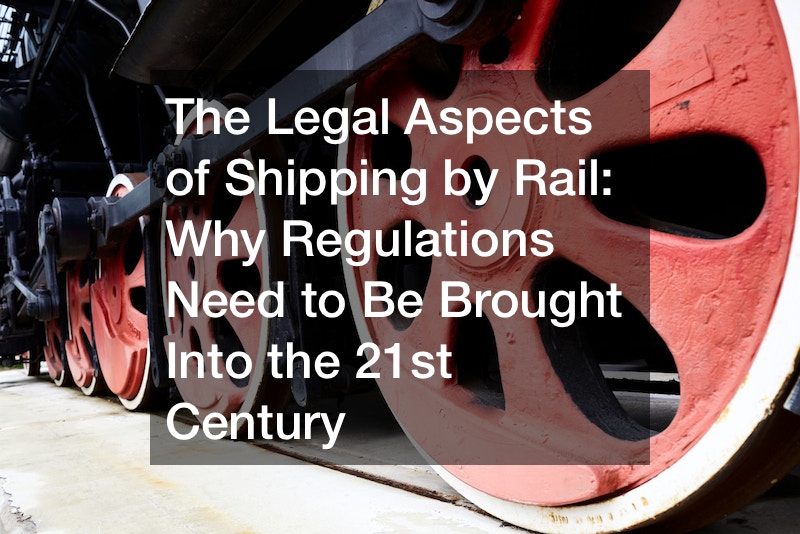Shipping by rail has been vital to this country’s economy for nearly two centuries now. Yet, many of the regulations and policies about such shipping still reflect that nineteenth-century thinking. Lack of regulatory flexibility and creative thinking sometimes makes it challenging to bring the law of shipping by rail into the 21st century. This article will examine some of these continuing obstacles to modernizing the law of shipping and the legal aspects of shipping by rail.

Today’s Regulations
The current approach to regulating freight rail injury continues to reflect 19th-century proscriptive thought about the legal aspects of shipping by rail. This mindset makes incorporating new safety and performance technologies into the regulatory environment extremely challenging, thus impeding progress in safety and efficiency, as well as the legal aspects of shipping by rail. Creating a regulatory environment in which applicable regulations can efficiently acknowledge new technology is vital to modernizing the legal aspects of shipping by rail. In other words, a healthy system would continue to hold railroads responsible for the safe performance of their tasks and enable them to deal with new technologies quickly and incentivize them to do so.
Despite the passage of the Staggers Rail Act of 1980, loosening regulation somewhat and giving railroads broad authority over business practices and the legal aspects of shipping by rail, some issues continued to face regulation by the Interstate Commerce Commission (ICC) to prohibit predatory pricing and to prevent concentration of market share. The intent was to protect shippers with no access to competition in their shipping choices. However, in 1995, the ICC was eliminated and replaced by the Surface Transportation Board, with less power and size. Since then, there has been really no competition or protection from unreasonably high rates. Today, four rail freight companies control the vast majority of US rail traffic, enforced by regional monopolies. This monopoly power increases US goods prices, giving foreign manufacturers an advantage in our markets.
Currently, Congress is considering legislation that would create a fairer and more competitive market for shipping by rail. Since the bill has only Democratic sponsors, its fate in January’s new Congress is uncertain. Nonetheless, predatory and uncompetitive pricing remains one of the pre-eminent hot topics among the legal aspects of shipping by rail. Dozens of industry groups in agriculture, manufacturing, chemicals, transportation, forest, and paper products, and the various railway unions support the legislation.
Other legal and regulatory issues that arise in rail freight include:
- Dissimilar Legal Systems – all shipping agreements must cover the rules and regulations of every jurisdiction through which goods will pass. The agreement and its parties must anticipate everything from a shipper’s corporate structure to its packaging practices.
- Shipping Logistics – Keeping track of all the paperwork and regulations is a big job that grows exponentially as the length and breadth of the shipment expand. Some system or other (software is now available) must be developed to make sure all documents are completed, signed, and retained for every shipment. Using one of these systems or having dedicated staff to handle these logistical issues can help manage many of the legal aspects of shipping by rail.
- Cybersecurity – Data breaches can endanger an entire shipment and make the goods subject to theft or other problems. Moreover, shippers will have to deal with any such breaches under the privacy laws of each jurisdiction to which the shipment is subject. Given today’s cyber environment, having a robust cybersecurity program may be one of the most important legal aspects of shipping by rail.
- Bad Paperwork – Badly prepared or incorrect paperwork can create substantial legal liabilities. In-house legal and compliance staff should track all this paper to ensure that no unnecessary legal issues arise because the paperwork wasn’t correctly processed. Failing to do so can often prevent significant fines and potential bans on future shipments.
- Uninsured Shipping – If a shipper does have a problem and isn’t adequately insured to cover it, the legal exposure increases immensely. There may be legal obligations to carry insurance on a shipment, or it may simply cover liability to a customer for a destroyed shipment. In either case, not having it can be financially catastrophic.
- Reputation Risk – Having any of these kinds of problems also constitutes a risk to the shipper’s reputation and, therefore the long-range viability of the company. It is better to plan to avoid these kinds of issues than attempt to repair them post-disaster. Reputation risk can be one of the most significant legal aspects of shipping by rail.

What Ships by Rail
More than half of all freight shipped by rail consists of bulk commodities, the remainder shipped by rail consists of bulk commodities, the remainder shipped by rail consists of bulk commodities, and the remainder consists of bulk commodities, with the remainder comprised of consumer goods and other manufactured products. The bulk commodities include:
- agriculture and energy products
- automobiles, other motor vehicles, and their component parts
- construction materials and equipment
- chemicals
- Miscellaneous equipment
- food
- metals, minerals, and other substances
- paper and paper and rag pulp
The smaller ‘half’ of rail freight is intermodal shipping, using easily transferable shipping containers, carrying consumer goods and other miscellaneous products. Now let’s look at some specific shipping and shippers and the legal aspects of shipping by rail raised by them.
Medical Supply
From large x-ray and CT machines to medical supplies, shipping medical items requires expertise and knowledge of the legal aspects of shipping by rail. For example, a shipment may often involve hazardous materials that must be packaged and shipped in compliance with federal and state hazmat protection. If the items are shipped internationally, additional steps such as vapor-barrier bagging, special moisture removal, activated desiccants, and other measures may be required to protect your assets adequately. Again, your medical supply company or your shipper must also be familiar with foreign rules relating to shipping medical supplies. If there are hazardous materials in your shipping, you must consider UN-certified packaging and be in compliance with various Department of Transportation regulations. Finding a packer or shipper who handles medical items like radioactive materials and hazardous medical waste may be challenging.
Construction Materials
Post frame building materials (like pole barns) and their components often spend at least part of their journey to the consumer on the rail freight system. Other construction materials do, as well. Whether it is the large components such as trusses or the structure itself, the shipping must comply with federal and state locations relating to load size and other issues relating to the legal aspects of shipping by rail. Packages for this construction are also huge and often challenging to ship. Compliance with applicable packaging regulations and contractual terms raises significant legal issues in shipping by rail.
Commercial Laundry Equipment
Mainly when shipping internationally, those who manufacture and ship commercial laundry machines are governed by requirements for permits, customs, government regulations, and carriers imposed by the rail freight companies themselves. Each region through which the commercial laundry machine travels will have unique and sometimes contradictory requirements applicable to that shipment and the legal aspects of shipping by rail.
Fork Lifts
Fork lift dealers generally ship their equipment in an open-air mode, such as a flatbed rail car or a specialty car designed for holding heavy equipment. Other shippers will use intermodal shipment for smaller industrial equipment, allowing movement from one shipping vehicle to another with limited time and increased efficiency. Intermodal shipping is often used for international shipping since certified carriers can pre-cleared borders. Nonetheless, the proper preparation and handling of intermodal shipments can be one of the critical elements in the legal aspects of shipping by rail.
Metal Goods
Metal fabrication creates sheet metal and other flat metals conforming to specific requirements. A fabricator needs to be able to assist buyers with the proper shipping and packaging of its products, as well as the related legal aspects of shipping by rail. Whether domestic or foreign, the fabricated metal goods must comply with all shipping and packaging regulations in the jurisdictions through which the goods pass. The best fabricators will have experience in assisting with these matters.
Farm Equipment
Farm equipment has gotten enormous and has concomitantly enormous tires. Transport regulations that are in place for all farm equipment to protect others from potential accidents and to protect goods are a significant part of the legal aspects of shipping by rail of agricultural equipment, including tractor wheels. Federal and state laws (and, of course, those of other countries, when applicable) govern the packaging, security, and other shipping issues for tractor wheels and other farm equipment.
Tools and Supplies
An object which helps to solve a physical problem is a tool. Builders, contractors, manufacturers, and almost any entity in the business of making or shipping goods needs tool supplies. This universal need leads to the crisis caused when the supply chain reduces the efficient shipment of tool supplies.
Contractor Supplies
One of the primary issues facing those shipping contractor supplies today is the supply chain crisis, which impacts contractor supply businesses. Shipping, including shipping by rail, is both a cause and a victim of the supply chain crisis and is a primary legal aspect of shipping by rail. It’s helpful that the contract between the parties to a shipment deal relating to supplies for contractors will allocate responsibility and liability in relation to shipping issues. This is particularly important where customer claims for late-delivered goods put a company at regulatory or litigation risk. Contracts must address ownership and liability issues when delivering supplies to contractors by rail to reduce the likelihood of litigation.

How Does It Ship?
As mentioned previously, a great deal of rail freight goes in shipping containers that can easily move between freight cars, ships, and trucks. However, there continues to be a variety of freight cars. Among the more common cars are:
- Boxcars– the enclosed rectangular car that you always think of first in relation to freight; typically shipping consumer and canned goods; auto parts, paper, bagged products
- Refrigerator cars– cars with a cooling apparatus to keep the cargo cool or cold, used for perishable or frozen food items.
- Flatbed cars– as the name implies, a flat open bed for carrying large or irregular cargo such as poles and pipes, logs and lumber, and, most importantly, intermodal shipping containers
- Hopper cars– designed to transport loose commodities. The open or closed cars are loaded from the top with doors at the bottom or sides, typically transporting sugar, corn, and other grains; fertilizer, coal, metal ores, salt, and sand.
- Tank cars– designed to carry liquids and gases such as oil, water, liquid chemicals, petroleum products, and liquid hydrogen
- Gondola cars– open-topped cars with low sides designed to carry heavy bulk cargo like scrap metal, gravel, and rail tracks and ties. They have no doors and must be manually unloaded.
- Specialty cars– There are cars for carrying motor vehicles, aggregate, ballast, and miscellaneous items.

Cross-Docking and Transloading
It is pervasive today for freight to be transferred from one mode of transportation to another during shipping via cross docking and transloading. In cross-docking, the inbound freight is unloaded from one vehicle, held briefly, and loaded onto another. Transloading is when inbound freight gets unloaded and sorted into new pallets for outbound shipping. By allowing for consolidating smaller shipments, both methods can reduce costs and raise efficiency. Both will require compliance with all regulations in any jurisdiction through which the shipments travel, one of the significant legal aspects of shipping by rail.
Other rail shipments will go directly from the manufacturer to the recipient via the use of rail sidings, allowing for immediate delivery without cross docking and transloading.
Conclusion
Whatever goods are being shipped by rail to whichever location, there will be legal aspects of shipping by rail. All parties to such shipments must be familiar and compliant with all applicable laws and regulations.



